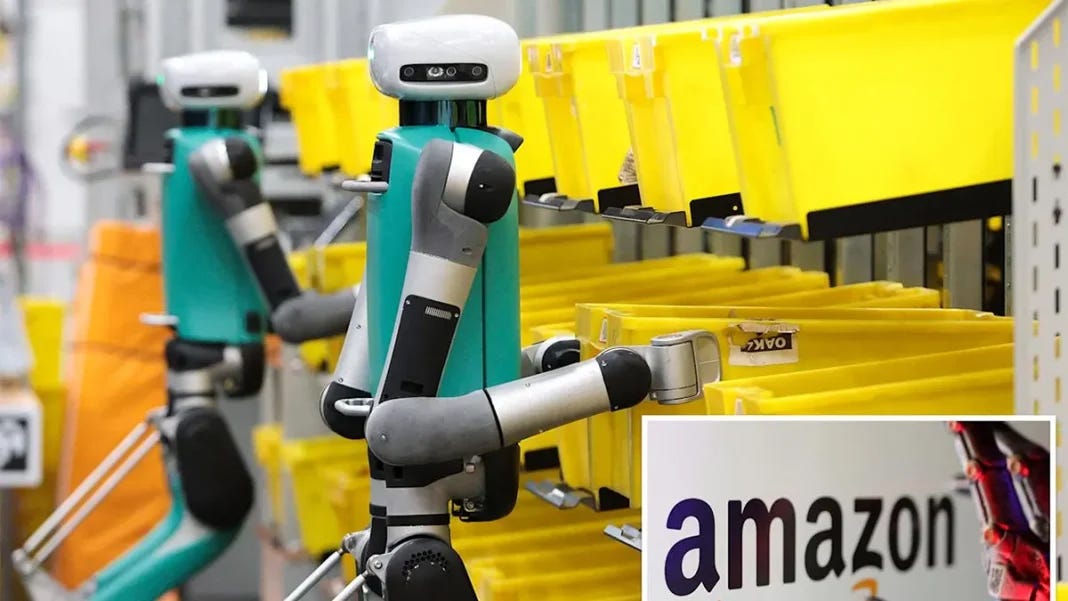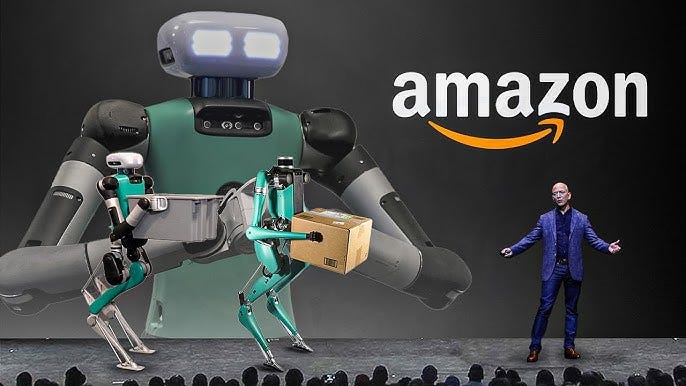BioWire Bytes 005 - The Robots are Coming! Amazon deploys 1 millionth robot.
Byte-sized Biotech
If it seems like our coverage lately has leaned heavily into AI, robotics, and automation, you're not imagining things. There are just too many important milestones occurring to overlook, and we quietly passed another. Just last month, Amazon announced that its robotic workforce had crossed the one-million mark. These robots come in all shapes and sizes, each optimized to enhance the efficiency of Amazon's sprawling fulfillment centers. Given the timing, right around Prime Day, I couldn't resist highlighting this news. So, the next time you enjoy same-day delivery, remember there's a growing army of robots working behind the scenes to make it possible.
First, if you enjoy these updates, consider subscribing and becoming a part of our growing community!
DeepFleet is The AI Traffic Controller Behind Amazon’s Million-Robot Fleet
An Amazon mobile robot navigates a warehouse aisle beneath towering inventory shelves – part of a robotic workforce now one million strong. Amazon’s warehouse empire quietly notched an extraordinary milestone this summer with the deployment of its one-millionth robot helper. This shiny new addition, delivered to a facility in Japan, pushed Amazon’s automated workforce across 300+ fulfillment centers worldwide. If hitting a seven-figure robot population wasn’t enough, Amazon simultaneously unveiled DeepFleet, a generative AI foundation model designed to choreograph this vast mechanical army.
Will it actually be Skynet this time? Probably not..
According to Amazon, we can think of DeepFleet as the traffic controller guiding robots through Amazon’s aisles. With over a million mobile units zipping around carrying shelves and packages, even a little congestion can slow things down. DeepFleet tackles this by optimizing each robot’s route like a city-wide navigation system, reducing unnecessary detours and idle time. The result is about a 10% improvement in fleet travel efficiency, a modest-sounding tweak that actually translates into faster order processing and delivery, and lower costs for customers. In other words, your package may get to your doorstep that much quicker.
This achievement has been over a decade in the making. Amazon’s robotics journey began in 2012 with a single type of robot that ferried inventory across the floor. Today, that humble start has evolved into a diverse ecosystem of warehouse robots, including the shelf-lifting Hercules units, the Pegasus bots sorting individual parcels, and Proteus, a free-roaming robot that works safely alongside humans. At least for now, these automatons are working with people, not replacing them. Amazon has upskilled 700,000+ employees since 2019 through robotics training, turning warehouse associates into technicians who build, program, and maintain advanced automation. In fact, one of Amazon’s newest high-tech fulfillment centers in Louisiana ended up needing 30% more human workers in engineering and maintenance roles to support its fleet of robots. With all the negativity surrounding robots and AI replacing human labor, this is a hopeful sign that robots can mean more jobs in some cases.
In more good news, Amazon also manufactures its robots domestically in the U.S., working with domestic companies. They believe that this in-house approach produces higher quality and creates a “valuable feedback loop” between the engineers designing the robots, the teams building them, and the warehouse employees using them.
We hear a lot of hype about generative AI and robots. But this is a prime example of meaningful deployment; robots to facilitate manual labor and AI to optimize travel time. According to Amazon, it’s “creating tangible benefits: faster delivery times, lower operational costs, and reduced energy usage” in the real world.
Before I wrap up, I want to emphasize again how staggering this milestone of one million robots truly is. Amazon currently employs approximately 1.56 million people worldwide. Given the company's rapid trajectory, it's reasonable to expect that Amazon’s robotic workforce might surpass its human workforce by year's end. Indeed, their rate of robot adoption appears exponential. I can't help but wonder when robots, in general, might outnumber humans globally. It’s likely sooner than most of us imagine or are ready for. A very sobering thought.
These newsletters take significant effort to put together and are totally for the reader's benefit. If you find these explorations valuable, there are multiple ways to show your support:
Engage: Like or comment on posts to join the conversation.
Subscribe: Never miss an update by subscribing to the Substack.
Share: Help spread the word by sharing posts with friends directly or on social media.
https://www.aboutamazon.com/news/operations/amazon-million-robots-ai-foundation-model





"Amazon has upskilled 700,000+ employees since 2019 through robotics training, turning warehouse associates into technicians who build, program, and maintain advanced automation. In fact, one of Amazon’s newest high-tech fulfillment centers in Louisiana ended up needing 30% more human workers in engineering and maintenance roles to support its fleet of robots. With all the negativity surrounding robots and AI replacing human labor, this is a hopeful sign that robots can mean more jobs in some cases."
If there's no negatives to this for the workers, then that is indeed very hopeful.
A million robots is crazy. Hard to wrap my head around!
That 17/hr pay reduction gonna feel way worse than not receiving a $3/hr wage increase